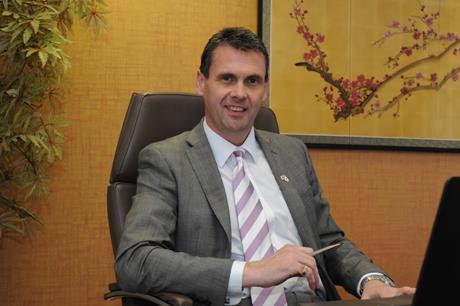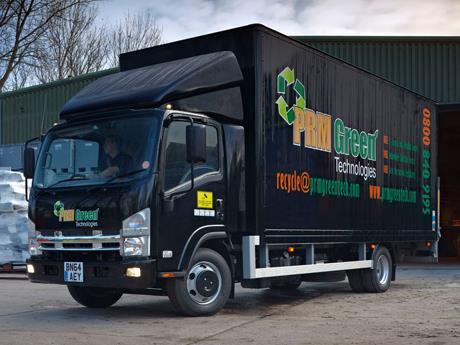
Pete Murphy took over as MD of Isuzu Truck (UK) in November 2013 after founder Nikki King sold the business and became honorary chairman. The genial Geordie took the reins at an interesting time for the UK truck market, with the turmoil of a change in Euro emissions standards about to hit.
Despite placing the “biggest order ever” with the factory for Euro-5 trucks in 2013, Murphy admits he ran out of trucks early in 2014.
“We had a few sleepless nights over the amount of cash we had spent but the reality is I wish we doubled it because it just flew out,” he says. “We have a five month lead time on orders placed with the factory so some of our European competitors with shorter lead times could build in October, November and December, and register them within that period. I think one of our European competitors sold four times in December 2013 what they normally do.”
More complex
To make things more complex Isuzu switched production of the new Euro-6 range to its factory outside Verona, Italy, at the same time launching the new Urban N75.150. This is a 7.5 tonner powered by a 3litre 150hp engine, a lighter alternative to the 190hp 5.2litre version.
“It was a new product, a whole new assembly process and there were delays there,” says Murphy. “It gave us a few headaches going into Euro-6 as we didn’t have the availability. The other thing which worked against us was that we were launching the 150 as well. There was a lot of interest in the 150 and some people delayed ordering the 190 until they tried the 150. But last year we recovered once the vehicles came in and we were the only manufacturer of 7.5 tonners that was actually ahead.”
Murphy was concerned that customers would just switch from the 190 to the 150, but in fact both ratings have seen sales growth.

“There has been a lot of organic growth because of the 150,” he says. “We’re currently 16% up on plan for the 150 and 11% ahead of plan on the 190 as well. We’ve found some new markets for the 150. For instance it’s proven incredibly popular in retail and construction.
“By having the two of them it’s allowed the dealers to ask customers about their operation. They can then recommend the 5.2 litre for maybe bigger mileage and harder driving work or for lower mileages they can recommend to the customer that it’s a 3 litre. So it’s really benefited the whole 7.5 tonne sales of the company.”
Dealer network
Murphy wants to grow the Isuzu Truck dealer network, especially in Scotland, to improve its UK coverage. It currently has around 49 franchised dealer outlets, of which just over 35 offer sales as well as parts and service.
“We’ve identified that we need to plug some gaps,” says Murphy. “Obviously the Isuzu brand has always been synonymous with excellent customer service and we just want to make that customer experience in some of the far-flung areas better.
“We are looking to introduce another category which is service only which means it’s less investment for someone in an area where there maybe isn't a vehicle parc. The idea is, if they have the right level of service, training and diagnostic equipment, they can remedy a problem with a vehicle very quickly.”
Isuzu Motors Japan now owns 100% of Isuzu Truck (UK), and Murphy recently had to go to Japan to present his sales forecasts out to 2019 – “one of the scariest things I have ever done” and says he has “committed to some fairly aggressive growth plans”.
“We are going to need a wider range of products to achieve those volume levels but we are certainly aggressive,” he says. “We are really optimistic about how things will go.
“The UK is an absolutely key player for Isuzu in terms of Europe. One of the difficulties with product extension is that, while Euro-6 is probably going to emerge as the global standard, the fact is Europe has adopted it long before any of the other marketplaces where Isuzu sells in volume.
“Then factor in the right hand drive element - Australia was going to go Euro-6 originally in 2017 and that’s moved to 2020 and beyond. The problem that we’ve got is that, in terms of the R&D development of some of the engines, it’s maybe too early to start the process. But Isuzu is really focused on Europe. They definitely want to make it happen and we will get the products that we are looking for.”
Testing ground
The Japanese parent company sees the UK as a good testing ground for the rest of Europe, so Murphy is listened to when he tells the factory what his customers want.
“There are a number of studies underway,” he says. “If you are never going to get something, it’s easy to say what you want. If there is a chance that you might get it, you have to choose wisely. We launched some bigger vehicles back in 2008 and some of the specifications maybe weren’t great for the UK. It’s important to understand what your market wants and if it takes a bit longer to deliver on that in the long run it is time well spent.”
Isuzu has traditionally been strong in niche markets such as home delivery, plant hire, food service and vehicle recovery, sectors that value the low narrow cab that is easy for the driver to access and can appear less intimidating around town. While Murphy does not want to turn away from these he sees the new range as having a broader, more mainstream appeal.
“I joined the company in October 1998 and the 7.5 tonner had just come in that summer,” he recollects. “It was very different and some people thought it had come from Mars. Now I think it looks far more European than it did back in the early days.
“This year we launched the best specifications in the 7.5 tonner, and they are as a direct result of the feedback that we gave in January 2014. They listened and made these things happen which is incredibly encouraging moving forward.”
Easyshift
Murphy expects the new 7.5 tonner will be a popular base for horseboxes too.
“That’s because it still kind of drives like a car with that Easyshift automated box,” he says. “It’s a 7.5 tonner but it’s really easy to drive.”
Nearly 90% of Isuzu 7.5 tonners are now specified with the automated gearshift. “When we get demo reports one of the first things it’s complimented on is the drive train in combination with the gearbox,” says Murphy. “It’s a great bit of kit and it proves really popular with customers and drivers.”
Isuzu also launched a new 12 tonner at the 2015 CV Show, so the next thing on Murphy’s wish list would be a lighter 3.5 tonner. “Weight is the penalty for having it as tough as old boots,” he says. “It is built like a truck so it can’t be as light as a van. You can’t have it both ways, it’s one or the other.”

Murphy has not seen any sign of a drift from 7.5 to 12 tonners as the pool of older drivers with grandfather rights to drive a 7.5 tonner on a car licence dwindles.
“The 7.5 tonner is by far our biggest seller,” he says. “In terms of it going to 12 tonnes, that’s not happening yet. If anything if you look at the growth in vans and 3.5-tonne chassis cabs it’s going the other way.”
Murphy believes it is time to review the current 3.5 tonne threshold for O-licensing as it is creating some anomalies in the market.
“Should you move the threshold down for O-licensing, bearing in mind now that a lot of builders for instance don’t need a tonne of sand in the back because the builders merchants deliver the heavy stuff?” he asks. “Or should you move it the other way and take high range vehicles out of scope?
“Where it is now is mad but the minute they do either one of those two things, people will stop buying 3.5 tonners. You have the same footprint of vehicle that will technically carry more, and reducing the number of vehicles that are out there benefits the environment enormously.
“Maybe we have pushed it about as far as we can at 3.5 tonnes. Manufacturers are reducing the capacity of engines to try and make them lighter which may or may not prove to be the right thing in terms of reliability. At some point it’s got to move one way or the other and maybe the time is right to look at the kind of people who are operating at 3.5 tonnes that don’t need that capacity. Then look at the people who are operating 3.5-tonne vehicles who really need more capacity and are struggling to cope on the limits.”
At present, Isuzu’s UK line up stops at 12 tonnes and Murphy is keen to re-introduce an 18 tonner or at least something between the two weights.
“We’ve got Euro-6 capability with the 240hp four cylinder engine which is in the 12 tonner,” he says. “That’s quite a powerful engine for a 12 tonner so there’s capability for something somewhere in between. The UK market wants six cylinders at 18 tonnes so maybe if acceptance of a four cylinder 18 tonner was greater we probably have a better chance of getting something sooner rather than later.”
Despite the appreciation of the Yen since the financial crisis of 2007, Isuzu has managed to remain competitive on price with its European rivals.
“If you look at the retail sector we’re very competitive against the competition,” he says. “But the reality is, it just depends how much manufacturers want certain deals, and if they absolutely want to win it they’ll throw the kitchen sink at it. So pricing is a more complex debate.”
Chinese threat
Does Murphy worry that the constant focus on building better higher quality trucks by the European and Japanese manufacturers will leave the door open for a cheap and cheerful vehicle from China?
“I think anybody who ignores the capability of China is being a bit naive because who knows what that huge continent is capable of doing, both in terms of being a potential customer and also being a potential supplier,” he says “I don’t really know what impact there might be, though I know there’s some talk about a Chinese product which could be here soon.
“One thing you learn in this job is if you worry too much about in the future you’ll be an insomniac so I can’t worry about the things that I can’t control. If it happens we’ll deal with it.”
Murphy’s predecessor Nikki King was devoted to delivering the best customer care in the UK truck market, and Isuzu Truck has been a long term sponsor of the Motor Transport Customer Care Award. King famously gave her home number to every buyer of an Isuzu truck to call if they had a problem they could not resolve through the usual channels.
So has Murphy kept up this tradition?
“No, and I’ll tell you why”, he says. “I don’t give my home number out because Nikki still does. She’s our honorary chair and the reality is I don’t live at home that much. In addition to this, Nikki’s daughter, Lisa Smith, is our general manager heading up Care, so this works seamlessly. Obviously, my mobile number is on the welcome letter too.”














